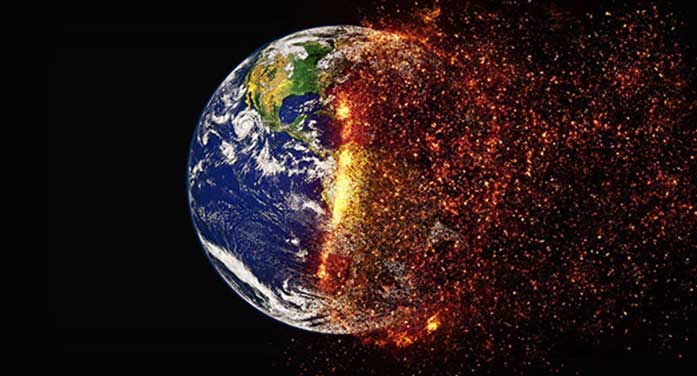 In a recent article about climate change, Associated Press science writer Seth Borenstein gave us a master class on how to sell the results of a computer model as if it represents reality.
In a recent article about climate change, Associated Press science writer Seth Borenstein gave us a master class on how to sell the results of a computer model as if it represents reality.
In his world, a group of scientists can take a short-term heat wave, crank it through an “ensemble” of theoretical mathematical climate models and ta-da! They can ascertain that this heat wave was “virtually impossible” unless caused by human-induced global warming. Further, they can predict that the climate-change-driven heat wave will incontrovertibly kill people in the range of hundreds to thousands in the weeks to come.
Now, don’t get me wrong, I’m not a climate denier. I think climate change is as real as gravity, or mass or momentum, or Newton’s laws of motion or Einstein’s general relativity.
However, the computer models that have been offered to the public as portraying the reality of the global climate (and humanity’s influence upon it) are massively oversold: they are computer simulations slightly more elaborate and refined, but substantively little different than any other environmental simulation you would find in your favourite video game.
With all due respect to our friends in the climate science community, we do not live on Planet ClimateModel, and climate simulation models are not the reality, nor are they science. They don’t illuminate reality; they don’t produce evidence; they aren’t measurements of the physical; and they can neither predict the future accurately nor characterize the past.
 Climate models can’t be validated by comparison to a genuine control of climate past or future; nor can they be disproven in the sense that normal science has to be disproven. Their range of possible outputs, driven by arbitrary assumptions about how the climate works, covers virtually all potential eventuality and can always claim to have been correct in hindsight.
Climate models can’t be validated by comparison to a genuine control of climate past or future; nor can they be disproven in the sense that normal science has to be disproven. Their range of possible outputs, driven by arbitrary assumptions about how the climate works, covers virtually all potential eventuality and can always claim to have been correct in hindsight.
How oversold is this idea that models are reality?
Borenstein states that “A study, not yet peer-reviewed, said that before the industrial era, the region’s late June triple-digit heat was the type that would not have happened in human civilization.” Considering that the record of measured global temperatures only starts in 1850 (and it was extremely sketchy until the 1970s), that’s quite an extreme claim. In human civilization? Would it not have happened? Would any reputable scientist support the idea that their model is capable of proving these claims?
I rather doubt it.
Further, we’re told by one of the scientists quoted, “This type of extreme heat ‘would go from essentially virtually impossible to relatively commonplace.’”
What’s that based on?
Comparing models of climates past and future to other models of climates past and future.
Think I’m exaggerating?
“The team of scientists … logged observations of what happened and fed them into 21 computer models and ran numerous simulations. They then simulated a world without greenhouse gases from the burning of coal, oil and natural gas. The difference between the two scenarios is the climate change portion.”
“Without climate change, this event would not have happened,” said author Friederike Otto, a climate scientist at Oxford. “Would not have happened.” An absolute statement, from an abstract thought exercise.
But not to worry, six other scientists cited (but not all quoted) in the Borenstein piece tell us that the study “made sense,” and if anything, underestimated the situation.
How exactly one can say in the same breath that something makes sense and yet is known to be an underestimation in several different dimensions has yet to be explained.
But the same is true of all models, which, we are assured regularly, are so much better than previous models, which were all wrong (oddly, always wrong in the same direction of underestimating risk). Even though, at the time, those models, too, were portrayed as the truth.
So before you get too worked up about the heat wave on Planet ClimateModel and buy into government techno-schemes like banning new gas-powered car sales by 2035, mandating net-zero carbon emissions by 2050, or “let’s jack up the carbon tax,” take a deep breath and remember that climate models are no more real than concept car models, architectural models, economic forecast models, government budget models, perpetual-motion models or lingerie-clad Instagram influencer models.
Actually, the latter might be more real than the former.
Kenneth P. Green is a research associate with the Frontier Centre for Public Policy.
Ken is a Troy Media Thought Leader. For interview requests, click here.
The Frontier Centre for Public Policy is an independent Canadian public policy think tank. It does not accept any government funding whatsoever. It relies on diversified funding to maintain its independence.
The views, opinions and positions expressed by columnists and contributors are the authors’ alone. They do not inherently or expressly reflect the views, opinions and/or positions of our publication.
© Troy Media
Troy Media is an editorial content provider to media outlets and its own hosted community news outlets across Canada.


